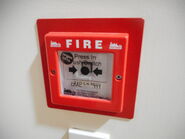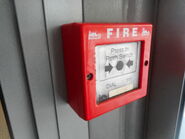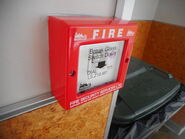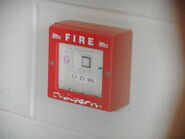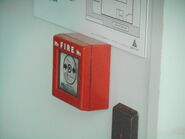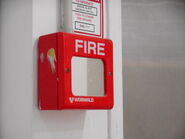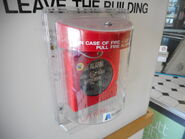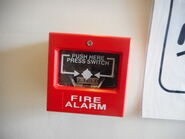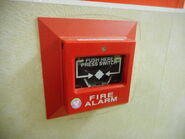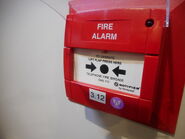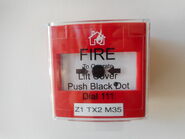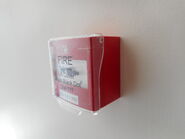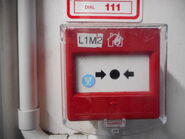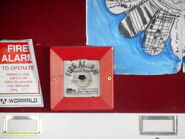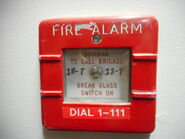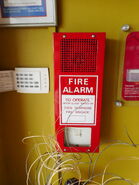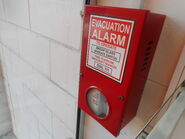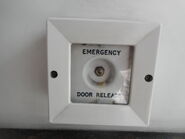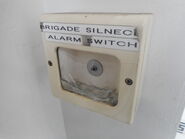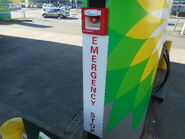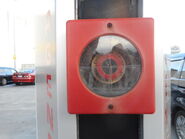This page includes all Manual Call Points, Emergency Door Releases and any other uses for an MCP device.
Manual Call Points - Introduction[]
A Manual Call Point (American's may know them as "Pull Stations") is a special switch that can be pressed to activate a fire alarm in an emergency. New Zealand has certain guidelines on how Manual Call Points (MCP's) have to be designed. The following is the exact wording from those guidelines:
Manual call points shall be of a strong, rigid construction. The method of operation shall be two-stage, either:
(a) The breaking or displacing of a frangible or resettable element followed by the manual operation of a switch; or
(b) The opening of a transparent cover or flap followed by the breaking or displacing of a frangible or resettable element.
All manual call points shall provide a visual indication of operation. This indication shall latch in the alarm condition until manually reset from the control unit.
As you can see, all MCP's in New Zealand have to be "two stage". This means that a protective layer of glass or plastic must be either broken or opened to access the switch. This is to prevent accidental activation in the event that someone hits that MCP by accident. Some MCP's have glass or plastic covers that you break, while others use a flap. Some MCP's have one-use covers (such as glass), therefore requiring them to be replaced after use, whereas others are re-settable.
Manual Call Points - Currently/Recently Manufactured[]
Pertronic "Switch Down" with SnapGlaze[]
These are very common two-stage MCP's, which require you to push in the SnapGlaze and then press a switch to the down position. "SnapGlaze" is a design patented by Pertronic that replaces glass with a plastic system, which simply 'snaps' (hence the name) out of the frame. This is much safer than glass, as you cannot cut yourself on it. Also, SnapGlaze is reusable, as it can be re-set by 'snapping' the pushed out piece of plastic back in again. This is much better than glass, which you have to replace when it gets broken. Pertronic currently only offers this MCP with the larger "rocker" switch (second to last picture). The variant with the smaller switch has been discontinued. Finding one with the larger switch is rare, as nearly all Pertronic MCPs these days use the push button (see below).
Pertronic "Push Switch" with SnapGlaze[]
These are the same as above, but use a push-button instead of a switch. These are a more recent design, and are becoming very common in both new buildings and refurbished old systems. These also come with the aforementioned "SnapGlaze"
Pertronic with "Break Glass"[]
Despite the invention of SnapGlaze, Pertronic does offer the option of the traditional "Break Glass" instead. These are actually very rare, and whenever they are used, it is usually because of low-budget reasons (the glass is cheaper than SnapGlaze). The only places I know of that has Break-Glass Pertronic MCP's are a couple of high schools (including my old one). Quite often is the case that the MCP had SnapGlaze when installed, but was replaced by glass either when the SnapGlaze eventually broke, or becuase the person resetting the call point was an idiot who didn't know it was reusable.
Pertronic with Round SnapGlaze[]
Pertronic used to make their weather-proof outdoor MCP's with the SnapGlaze in a circle-shape, instead of the usual square. They have since discontinued this. They are incredibly rare, and so far I have only found a couple. Most of these photos are from a single unit i found at Victoria University. The second is from Johnsonville Pool 9taken through a window. The third photo is of another, which has sadly been modified with a regular square Snap-Glaze installed behind the hole for the round one.
SnapGlaze Prototype?[]
Whilst exploring in Wellington, I found what appears to be an early prototype version of Pertronic's SnapGlaze MCP. Note that the detachable piece lacks the rounded corners, and is differently designed. Also take note of the red border on the actual switch itself.
Custom-Made Vigilant/Tyco w/ Pertronic Switch[]
The Old Bank Shopping Arcade in Wellington has these very unique custom-made call-points. they feature a brass plate instead of red plastic. The switch is a typical Pertronic CPPIN switch, however the shape & glass of these call-points more closely resembles Tyco/Vigilant's design. It is possible that these were made by Wormald and later had their switches replaced by Pertronic (or that Pertronic installed them and Wormald replaced the covers), but in all truth I have no idea.
Vigilant/Tyco Series 130 "Break Glass" (Tyco FP0324)[]
These MCP's are made by Vigilant/Tyco. They are similar to Pertronic's CPP "Switch Down", but use glass instead of plastic. This is disadvantageous, because you can cut yourself on it. It is also not reusable, so the glass has to be replaced with a new sheet each time it is broken. That said, the one advantage these MCP's have is that they are larger than Pertronic's, and have more red on them, as well as the word "FIRE" written in bigger letters, making them easier to see. These MCP's are mostly used by Wormald, however some other companies have been known to install them.
I have also seen a number of these call-points located outside some Fire Stations. I do not know the exact purpose of these, but I assume that it is to manually call out the fire brigade. There are no signs confirming this.
Vigilant 130 - Retrofitted with SnapGlaze[]
This is an incredibly rare occurrence, but I found a couple of Vigilant Series 130 MCP's that have had Pertronic SnapGlaze retrofitted. One of these is located in a school, and has the correct "switch-down" SnapGlaze fitted. The second, in an office building has the incorrect "press-switch" SnapGlaze, which has not been installed very well, as there is a gap (though maybe it just doesn't fit).
Ampac ACP-03 (Round-Glass MCP)[]
These are typical "Break Glass - Switch Down" MCPs. I have only found these is older buildings, but according to at the Ampac website, they do still make these. I have recently found one of these with a white label and the Pertronic logo, which I am assuming is just where one has been re-branded. It is also possible to find other white-labeled ACP-03's with other brand names on.
Ampac ACP-02 (Drop-Glass MCP)[]
These are quite rare. As with the previous Ampac MCP, I have only found these in older buildings, but their website says that these are still made. These work slightly differently to other MCP's. Instead of breaking the glass, pushing it causes it to drop down out of the way, providing access so the switch. The advantage to this design is that it can be re-set with a key, without needing to unscrew the whole unit (like you have to with SnapGlaze or Break-Glass MCPs). The only flaw with these, is that their black inside makes the tiny switch hard to see, and therefore harder to operate. This MCP would work better if it were bigger and white. Notice how its design closely resembles European-style MCP's.
Notifier (Honeywell) "European-Style" MCP[]
These are European-Style MCP's, which are offered by some companies. Pertronic also offers these as an alternative to their own MCPs. These have become a little more common recently, especially in new buildings. You can also get an Emergency Door Release version of this MCP as well. Sometimes these are branded as "Protec".
HyFire "European Style" MCP[]
This is another European-Style MCP. This one is not as common as the Honeywell one, and so far I have only found one installation of these.
Fulleon "European Style" MCP (Ampac ACP-05)[]
This is yet another European design MCP that is available for the NZ market. This is protected by a plastic flap, in accordance with NZ guidelines. This MCP is also available from Ampac, and is marketed as the "ACP-05".
Manual Call Points - No longer made[]
Vigilant Barrel-Shaped "Switch On""[]
These are some very old MCP's that were made by Vigilant. You can still find quite a few of these around, but they have long gone out of production, replaced by the Series 130 (see above).
RARE Barrel-Shaped "Push Knob"[]
This is a very rare version of Vigilant's old barrel-shaped call point, which uses a spring-loaded button (knob) instead of a toggle switch. These are super rare!
Guardian Alarms MCP[]
These are also an older design of MCP. They were made by Guardian Alarms, who in more recent years have stopped making these and switched to using Pertronic MCP's. There are few different designs for the white section, which usually says Guardian Alarms on, however there is one version I have discovered that does not use their name or logo (this a rare occurrence). I also found two of these with the Pertronic name on, for some reason.
Guardian Alarms MCP - Retrofitted with SnapGlaze[]
This is an incredibly rare occurrence, but I found a Guardian MCP that has had Pertronic SnapGlaze retrofitted to it.
VERY RARE - Old Guardian MCP[]
This is a super-rare old Guardian Alarms MCP that I recently discovered at Uni. I found eight units between two stairwells in the library. The north stairwell had them on floors 3, 4, 5 & 6 (other floors had either Ampac ACP-03's or Pertronic's), while the south stairwell had them on floors 5, 6, 7 & 8 (with other floors having either Pertronic's or the other type of Guardian MCP, above). One the face of this design, you could easily mistake it for being an older Vigilant design, but if you look at the white plate inside the MCP it does actually say "Guardian" at the top.
VERY RARE - Old Circle MCP (Ampac???)[]
This is an extremely rare old circle-shaped MCP. All of these photos were taken at the old Wakefield Hospital, which is currently awaiting re-building. Looking at the round design and the label inside, the look like they were made by Ampac (and the bells at this location are also made by Ampac, and there are a number of Ampac ACP-03's here.).
Rectangle MCP (Unknown make)[]
These rectangle-shaped Manual Call Points are dotted around the country, but I seem to be having difficulty finding them in Wellington. I am quite unlucky, in that most of the ones I have found have been in locations where I cannot photograph them. The one in the last picture is actually an Emergency Door Release. Why they've decided to use red with the "FIRE" text for an EDR is beyond me! EDR's are usually white or green.
VERY RARE - Old Unknown Square MCP[]
This is an old, small design that I have only ever seen one of. These were the only photos I could get. There does appear to be a manufacturer's name on it, but sadly I could not get close enough to read it.
Integrated MCP & Alarm[]
These are a very rare type of Manual Call Point that encompass the alarm within the unit itself. These can be used without a panel, in places that only need one alarm, or they can be connected to a very very basic on/off panel that simply connects the alarms together (so that if you have more than one of these, then one switch activates all alarms).
Vigilant 130[]
These are designed for very cheap installations that usually only require one Alarm & MCP. These are usually directly wired and do not have a panel.
Unknown make[]
I don't know who made these. Studying the toggle switch used, these appear to be made by the same manufacturer as the "rectangle design" above. These units contain a bell. They are no longer made becuase of new regulations requiring electronic alarm sounders since 2003.
Old Rounded integrated Alarm & MCP[]
This is an incredibly rare, large MCP that has an alarm integrated into. I do not know if the integrated alarm is a bell or an electronic alarm. Unlike other integrated units, which have the sound holes on the front, this design places them on the sides of the unit. This is easily the most common integrated call-point, and is also the only one i've ever seen connected to a panel!
Another Unknown Design[]
This is another unknown design, which appears to have an electronic alarm inside.
Emergency Door Release[]
These are used to release automatic or magnetic doors in the event of an emergency. These are sometimes modified manual call points. These are not required to be two-stage like MCP's, but sometimes are anyway. In New Zealand, EDR's are normally white, but you can get them in green, or even red!
Standard Door Release[]
These Door Release's are everywhere, and used by most companies, including Pertronic.
Vigilant 130 "Break Glass" Door Release[]
These are pretty rare, as most vigilant systems use the traditional EDR's seen later on this page. The last two photos are from a system that actually use Pertronic MCP's!
Ampac ACP-03 Emergency Door Release[]
I've only ever seen one of these. This is a white ACP-03 that has been re-purposed as an EDR.
Ampac ACP-03 combined EDR & Release Button[]
This is a very clever device! A lot buildings have buttons that you press to open the doors to exit when they're locked after hours, which is there in addition to the Emergency Release. Ampac has very cleverly combined both into one unit, with the steel unit.
Guardian Alarms Emergency Door Release[]
This is a white, modified Guardian MCP in use an a Emergency door release switch.
Notifier/Honeywell Door Release[]
These are exactly the same as they Notifier/Honeywell MCPs, but are used here as EDRs.
Older European-Style Door Release[]
These European-style "Press Here" Door Releases come in a few various designs. For simplicity, I've included them all here. The "Push Hard to Operate" ones are pretty common, but the other designs are fairly rare. Most of these are found on older systems. The design above is used on most new applications these days.
It is very common to find these without the cardboard behind the glass that has the print written on.
Sometimes these are used for other functions, besides EDR's.
Rectangle MCP/EDR (Unknown make)[]
This MCP has been re-purposed as an EDR.
Weird outdoor Door Release[]
I found this next to an outdoor gate at Te Papa Museum.
Panel Function Switches[]
These are modified call-points used control functions on the control panel. This may include "Silence Alarms", or other functions. These sometimes do not have the glass front, since it is not a requirement here.
Vigilant 130 "Silence Alarms" Switch[]
This is exactly the same as the door release above, but used as a "Silence Alarms" switch.
Ampac ACP-03 Panel Switch[]
Like many MCP's, the Ampac ACP-03 can be modified for panel functions, usually mounted on the back of the alarm panel. the first is a white one, with the usual switch. the second is a red one, which has a control knob in place of the switch.
Ampac ACP-03 "Silence Alarm"[]
This is a normal ACP-03 being used as a Silence Alarm switch.
Guardian Alarms control-panel switches[]
Some old control panels made by Guardian Alarms use white MCP's as switches for things such as emergency ventilation or silencing alarms. Sometimes these are installed without the front cover or break glass.
Fire Fighting Enterprises (FFE) "Silence Alarms" panel switch.[]
This a break-glass Silence Alarms switch I found on an old FFE panel. I do not know of any MCPs made by FFE, as this particular installation had Guardian Alarms and Pertronic Call Points instead.
Key Holder's[]
Sometimes, MCP's get modified to hold key's for certain things. This might be the key to panel, or maybe to a cupboard with the emergency supplies.
Pertronic Key-Holder[]
Pertronic also offers a white variant of their MCP's, which can be used for other functions, or alternatively can have the switch exchanged for a key holder.
Note that in these photos, the outer frame has been screwed on upside-down by mistake.
Vigilant 130[]
I have found these in both yellow and white.
Lift Shaft Ventilation Switch[]
This a rather rare thing, which is a modified MCP that activates smoke ventilation fans in lift shafts. So far, i have only found one.
Vigilant Barrel[]
A design similar to call points, but instead of a switch there is a pin to pull out. Used for emergency ventilation in a lift shaft.
Fuel Station "Emergency Stop"[]
These are found at many unmanned fuel stations (usually those owned by Pak n Save or New World). Pressing the button causes the fuel pumps to be cut out. They need a key to reset. Note that it is not required that these have the glass element on the front, but many do anyway.
Vigilant 130 Fuel Pump "Emergency Stop"[]
These are common at Pak N save and New World fuel stations, which are unmanned. These are modified Vigilant 130's that have a special STOP button inside. The button is pressed to cut the fuel pumps in the event of an emergency. It can only be reset with a key. These special units sometimes do not have any glass in them. Note that the first batch of photos come from a BP, however this actually used to be a Pak n Save fuel.
Ampac ACP-03[]
These were found at another unmanned fuel station (Pak n Save). These are modified ACP-03s that have a special STOP button inside. The button is pressed to cut the fuel pumps in the event of an emergency. It can only be reset with a key.
Unknown make[]
This is another emergency stop for an unmanned fuel station, but is not a Fire call point design. This is a typical red "break glass" unit with a push button inside. This unit actually has the cover in a hinge and can be opened with a key - a feature I am surprised that no MCP manufacturer has ever used!
Power "Emergency Stop"[]
At university, i found these modified Vigilant 130 MCPs, which are used to cut the power to a laboratory in the vent of an emergency.
Vigilant 130[]
I found a couple of these up at Uni, which are used a emergency power cut-off switches. These use the white front plate, but a red surface-mount box, which has had black & yellow tape wrapped around it.
Vintage Fire Station Call Point[]
Some fire stations have a manual call point outside, which you can use to call the fire brigade. These are usually Vigilant 130's (sometimes Wormald, sometimes Grinnell). Quite a few fire stations have actually stopped using theirs and deactivated them.
In Central Wellington, the Fire Station is a historic building, and they have preserved this beautiful vintage 1920;s Duplex call point. I doubt it does anything these days, and is probabaly here for decoration more than anything. The paint job is not original. See an original one here.

















